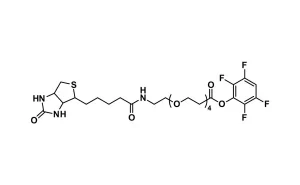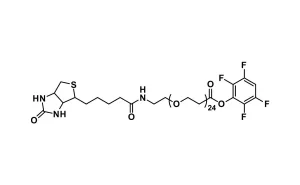Biotin-dPEG®12-TFP ester is an amine-reactive biotinylation reagent with optimal reactivity in the pH range of 7.5 – 8.5. The TFP ester is more hydrolytically stable than the corresponding NHS ester, providing better labeling of peptides, proteins, and other biomolecules.
Biotin-dPEG®12-TFP ester, product number QBD-10008, contains a biotin-functionalized dPEG®12 spacer that has been activated with a 2,3,5,6-tetrafluorophenyl (TFP) ester. QBD-10008 is part of a family of dPEG®-biotin reagents that provide different lengths of dPEG® between the biotin moiety and the reactive end group. The active esters can be either N-hydroxysuccinimide (NHS) or 2,3,5,6-tetrafluorophenol (TFP). Compared to NHS esters, TFP esters are more reactive towards primary amines and more stable in water or aqueous buffer. The optimum pH for reaction with TFP esters is in the range of 7.5 – 8.5, and for NHS esters the optimum reaction pH range is 6.0 – 7.5.
Biotinylation is the process of covalently attaching biotin to a molecule such as a peptide, protein, or nucleic acid, or a surface such as glass or gold. It is widely used in bioconjugation research and product development. Biotin usually is poorly soluble in water, but the amphiphilic dPEG® linker imparts excellent solubility in water or aqueous buffer and in an organic solvent. The 2,3,5,6-tetrafluorophenyl (TFP) moiety of biotin-dPEG®12-TFP ester reacts with free primary amines, such as the amines on the side chain of lysine, forming a stable amide bond. The biotin moiety is used in labeling experiments, supramolecular construction, affinity chromatography, the creation of biotinylated antibodies, enzyme-linked immunosorbent assays (ELISA), pull-down assays, and many other applications. Biotin-dPEG®24-TFP ester does not cause protein aggregation. This permits experiments that require a high degree of biotin labeling without concerns about loss of protein due to aggregation. Dissolution of the product in organic solvent is not required for conjugation, thus providing easier reaction setup and greater reaction reproducibility. The dPEG® linker in QBD-10008 is significantly longer than the linkers in LC-biotin and LC-LC-biotin. Consequently, dPEG®12-biotin provides better access of the biotin to the avidin or streptavidin binding pocket compared to these older, hydrophobic reagents.
| Unit Size | 100mg, 1000mg |
|---|---|
| Molecular Weight | 992.08; single compound |
| Chemical formula | C₄₃H₆₉F₄N₃O₁₆S |
| CAS | 3017961-69-9 |
| Purity | > 98% |
| Spacers | dPEG® Spacer is 40 atoms and 47.6 Å |
| Shipping | Ambient |
| Typical solubility properties (for additional information contact Customer Support) | Methylene chloride, DMAC or DMSO. |
| Storage and handling | -20°C; Always let come to room temperature before opening; be careful to limit exposure to moisture and restore under an inert atmosphere; stock solutions can be prepared with dry solvent and kept for several days (freeze when not in use). dPEG® pegylation compounds are generally hygroscopic and should be treated as such. This will be less noticeable with liquids, but the solids will become tacky and difficult to manipulate, if care is not taken to minimize air exposure. |
Applicable patents and legal notices are available at legal notices.


Stay in the Loop. Join Our Online Community
Products
Ordering
About Us
Application
Resources

©Vector Laboratories, Inc. 2025 All Rights Reserved.
To provide the best experiences, we use technologies like cookies to store and/or access device information. Consenting to these technologies will allow us to process data such as browsing behavior or unique IDs on this site. Not consenting or withdrawing consent, may adversely affect certain features and functions. Privacy Statement
How do I Request a Quote?
To request a quote for products: